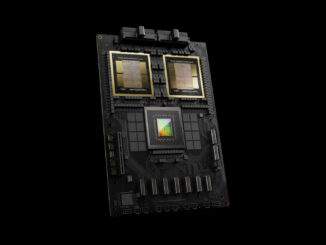
Wall Street might have unreasonable expectations about how OEMs and ODMs can profit from the GenAI boom through selling GPU laden systems. That seems to be the case as the stock shifters are picking on box shifter Hewlett Packard Enterprise, which has a nascent but not particularly profitable AI server business.
But those of us who have been around the HPC business for decades have no problem believing that wringing some profits out of “AI supercomputers” might be tougher than it sounds, and certainly tougher than the profit margins that Nvidia, the dominant supplier of AI compute engines, is able to extract from its massive revenue streams.
It has always been hard to make money in HPC, and AI will be no different unless and until it is widely embraced by enterprises – and it won’t be profitable for the OEMs and ODMs if they all opt for the cloud as their consumption model.
For decades, everyone talked about how HPC would democratize across all relevant enterprises, bringing the immense value of HPC simulation and modeling to the masses – the so-called “missing middle” in the common parlance. It largely didn’t happen, but Moore’s Law and competition did give HPC centers large and small access to cheaper and cheaper units of compute even as systems got more and more expensive because they wanted even more compute.
HPE had its own HPC business by virtue of its acquisition of Compaq two and a half decades ago, which had acquired Digital Equipment Corp and its fine technical computing business. And then HPE bought Convex, and then SGI, and then Cray because it has consistently believed in the democratization of HPC. These companies – DEC, Convex, SGI, and Cray – have all done amazing engineering work creating supercomputers, but if we added up all of their historical revenues and all of their historical costs in four separate ledgers, we strongly suspect that they would be break-even, and possibly only nominally – fractionally – profitable at best. That was certainly the case for all of the decades we tracked SGI and Cray.
And so, the question is: Why does anyone believe that the GenAI boom will be different?
As best as we can figure, it is because AI is the HPC that can, and very likely will, actually democratize across organizations – across all geographies and across all industry segments.
And so the question becomes, will HPE be able to sell such machinery to the masses, and therefore make a decent operating profit in the range of overall Server group goal of 11 percent to 13 percent of revenues? Or will HPE get into cut-throat deals competing against Supermicro, Lenovo, and other hybrid OEM/ODM suppliers and never get the profits? Because the profits come from the end users, as the cloud business most assuredly demonstrates. (See How To Make More Money Renting A GPU Than Nvidia Makes Selling It, our analysis from May 2024, for more on how that math works out.)
Right now, in the third quarter ended in July, HPE’s margins for AI servers do not appear to be improving, and in fact the transition to the latest ProLiant Gen11 machinery is hitting as companies are starting to buy traditional servers again. It is the sales of traditional servers, often bought in onesies or twosies but often by the dozens to hundreds, that is the profit center of HPE’s datacenter business. Just like it has been for every OEM. It is the low volume buyer who pays the highest premium, which only seems fair, and this is also why the cloud distribution model has been so hard on HPE. If companies give up on having their own gear, they stop giving HPE (and Dell and Lenovo and Cisco Systems) the profits and they start giving Amazon Web Services, Microsoft Azure, Google Cloud, Alibaba, Tencent, and Baidu even more profits as they rent out capacity on even cheaper ODM iron, for which the cloud providers charge a much larger premium over time than HPE and its OEM peers could ever hope to charge.
That HPE stays in the fight, and has bought HPC businesses to transform into AI businesses and stays in the OEM server business at all, squeezing blood from iron, is a testament to tenacity and generosity. It deserves to be commended because someone has to make the machinery the world needs so they don’t have to pay the cloud premium for IT. HPE deserves to have an extra goodwill item on its balance sheet, in fact – an actual “good will” that reflects the value it gives to IT shops who still DIY. This is of immense but measurable value. So get on that Financial Accounting Standards Board. . . .
For HPE’s sake, and for the sake of the many IT shops that still provide unique value to their companies, we hope GenAI does democratize and also stays sovereign. And if it does, then HPE, Dell, Lenovo, and Cisco will be able to ride up this wave much as they did the Dot Com buildout and as they have not really been able to do even as HPC went more mainstream than it was several decades ago.
Let’s Dig Into The Numbers
In the quarter ended in July, which was the third quarter of HPE’s fiscal 2024 year, HPE posted $7.71 billion in sales, up 10.1 percent year on year. Operating income rose by 16.1 percent to $547 million, but net income rose by only 10.3 percent to $512 million in the quarter. That net income represented 6.6 percent of revenues, matching the level of the year-ago period. And that is the problem Wall Street has – it didn’t beat it, and it didn’t match the level in Q4 F2-23, when net income was $642 million and was 8.7 percent of revenue.
Still, HPE is pocketing the cash, and its treasure chest had $5.96 billion in cash and equivalents, up 14.4 percent. This is not enough money to do a really big acquisition of any kind, but it has the financial resources to acquire former Cisco gadfly Juniper Networks for $14 billion in cash funded by term loans that will be converted to new debt and new stock at some point. HPE reaffirmed that it expected the Juniper deal to close in late calendar 2024 to early calendar 2025, and that the deal would be accretive to its profits, not dilutive as the AI server business is at the moment.
That AI server business – which HPE used to refer to as the APU Server business and which actually means a combination of HPC and AI machines that have GPUs or other kinds of accelerators as their main number-crunching compute engines – continues to grow for HPE.
In fiscal Q3, AI servers – again, really any servers using GPUs – drove $1.3 billion in revenues, up by a factor of 4.6X compared to the year ago period. And as you can see from the chart below, there is a tiny sliver of services revenue for these AI/HPC systems on top of that which was recognized during the quarter.
Given the history of the HPC business, which is pretty lumpy at times, Antonio Neri, HPE’s chief executive officer, was asked on the call with Wall Street analysts if there were any big deals that were driving its AI server sales in recent quarters.
“The quick answer is no,” said Neri. “There have not been very, very large deals or lumpy deals. It has been more spread and more uniform across the service provider space. And on the enterprise side, because obviously, we talk about this, the percentage of bookings relative to the $1.6 billion was, as a mix, in the mid-teens. So, very consistent with the prior year’s quarter. However, obviously, the dollars are much larger because now this quarter we booked $1.6 billion. So, I actually argue this is a good thing. And we don’t expect significant super-large deals, I’d call it, in Q4 based on what we have visibility in the pipeline, but more a continuation of what we saw in Q3.”
If you assume “mid-teens” means 15 percent, then of the $1.6 billion in bookings inked during fiscal Q3, enterprise buyers of AI servers will account for around $240 million in sales out of those Q3 bookings, and to put that into perspective, that is on the order of 600 eight-way GPU nodes, interlinked with InfiniBand or Slingshot interconnects. The remaining $1.36 billion in non-enterprise AI server bookings will eventually work its way onto HPE’s books, and represents maybe 3,400 eight-way GPU nodes with interconnects. (Obviously some of this will be four-way GPU machines with one CPU based on AMD motors, so double the node counts in those cases.)
Servers With A Smile
Here is the thing that has Wall Street upset. HPE increased AI server revenues by just shy of $400 million (our estimate), but the operating income of its Server group, where ProLiant sales and AI/HPC system sales are booked, was only 10.8 percent, down two-tenths of a percent from the prior quarter and essentially the same as the average for the prior four quarters and lower than the significantly higher margins the Server group had in the first two quarters of fiscal 2023, when it was 15.7 percent in Q1 and 14.4 percent of revenue in Q2.
As Q3 came to an end, HPE had an AI server backlog of $6.2 billion, and a pipeline feeding into the future backlog that was several times larger than this, according to Neri. Some of that backlog was the ABCI 3.0 supercomputer, which we wrote about back in July, that is going into the National Institute of Advanced Industrial Science and Technology (AIST) in Japan, which is based on the Nvidia GH200 Grace-Hopper nodes and which we estimate at 768 nodes.
What has saved HPE’s server profit cookies as it tries to build a book of business for AI/HPC servers for GenAI workloads is the fact that spending on “traditional” ProLiant servers for database and Web infrastructure workloads is starting to pick up, and also that HPE is starting to pass through higher component costs to server buyers when they shift. Marie Myers, HPE’s chief financial officer, added that it had put the squeeze on operating expenses in the Server group, too, which helped.
As far as we can tell, traditional servers grew by a mere 3.2 percent to $2.98 billion, and have been flattish at around that revenue level for the past three quarters. There’s a rebound, but it is against an easy compare this time around. In fiscal Q1, traditional servers were off 22.8 percent and in Q2 they were off 2.5 percent in our model of HPE’s financials.
Drilling down further, HPE’s Server group had sales of $4.28 billion, up 35.1 percent, with earnings before taxes of $464 million, up 45.5 percent. This earnings, as we said, represented 10.8 percent of revenues in the quarter.
The Hybrid Cloud group, which is a hodge-podge of storage, GreenLake system rentals, and various systems software, had $1.3 billion in sales, down 6.9 percent, with earnings of $66 million, down 12 percent. This seems to be more of a reason to be upset than AI server profitability if you ask us.
GreenLake, by the way, is growing smartly. During the quarter, nearly 3,000 new customers acquired gear through the GreenLake program, and nearly 10,000 customers have opted for GreenLake utility pricing in the past year, according to Neri. As HPE exited the quarter, there were almost 37,000 GreenLake customers.
It is tricky to get a sense of the health of the underlying core systems business at HPE, but each quarter we give it a whirl. Here is what it looks like now:
And, as you can see, the underlying systems business, when you wipe away all of the silly groupings, looks to be relatively healthy right now. By our model, core system revenues were up by 20.2 percent to $6.24 billion, and earnings before taxes for core systems rose by 32,8 percent to $595 million, representing 9.5 percent of revenues. The profitability level is still a few points lower than the historical average in the prior five years, but it is heading in the right direction this quarter.
We will see if this can start a trend. With a traditional server rebound under way and AI server cost controls set at draconian levels, perhaps it will.










AIST’s GH200-based ABCI 3.0 system looks iinteresting at 400 FP64 PF/s. Assuming these are peak, that will place it between Alps and LUMI, both HPE machines as well, in Top500. To Luis River’s comment on the AIST article (linked under “768 nodes”), the GH200 Grace CPUs are Neoverse V2 Demeters to A64FX’s Neoverse precursor, and the chip has this integrated H100 GPU for much extra oomph (both ABCI 1.0 and 2.0 also combined CPUs and GPUs, with V100s for one, and A100s for the other).
Most important though (IMHO) is power efficiency, where Fugaku’s A64FX-only architecture runs at 15.4 GF/Watt, Alps’ GH200 give it 52.0 GF/Watt of performance efficiency (3.4x better). I’d expect ABCI 3.0 to have similar efficiency to Alps. The upcoming Fujitsu Monaka could help if it readily pairs with GPUs as well.